Hawkes P.W., Spence J.C.H. (Eds.) Science of Microscopy. V.1 and 2
Подождите немного. Документ загружается.

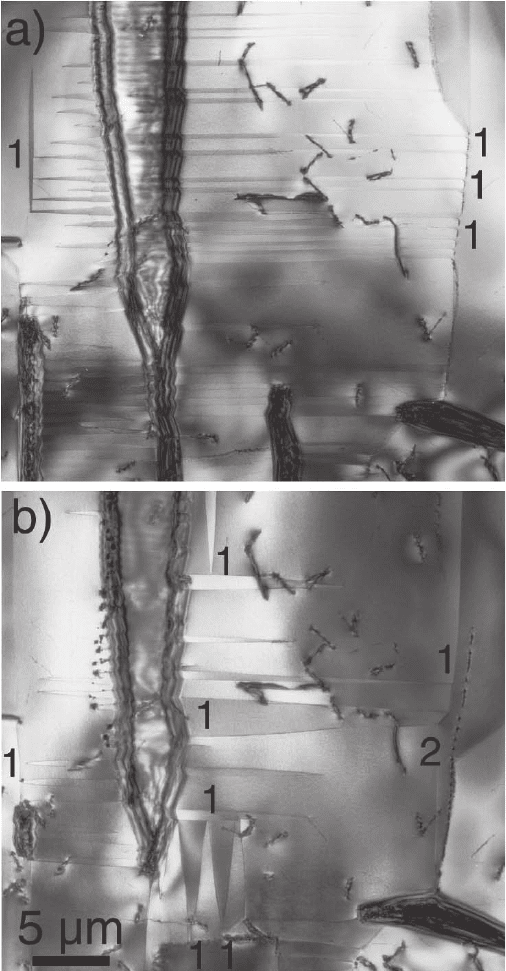
Chapter 6 In Situ Transmission Electron Microscopy 485
Figure 6–23. Domain wall motion in ferroelectrics under biasing. Bright fi eld images of single crystal
KNbO3 viewed close to the [010] direction. (a) Before applying an E-fi eld. (b) After applying the fi eld.
Initially, numerous needle-like 90º domain walls as well as dislocations (dark wiggly features) and
other domain wall geometries (vertical stripes) exists. On application of the fi eld, the needle like walls
move readily, coarsening the domain structure and forming straighter walls which then move less
easily. This is because curved and tilted 90º domain walls (indicated by 1) must support a geometri-
cally required Maxwellian displacement charge hence experience a direct force from an applied fi eld,
while charge-neutral domain wall regions (indicated by 2) do not experience a direct force. This sug-
gests an intrinsic mechanism of fatigue. (Reprinted with permission from Krishnan et al., © 2000.
American Institute of Physics.)
486 F.M. Ross
By analogy with the magnetic phase transitions described in Section
4.1.3, ferroelectric phase transitions may be examined by applying
an electric fi eld in situ. An example is the electric fi eld-induced trans-
formation of incommensurate modulations in Sn-modifi ed Pb(Zr,Ti)O
3
(He and Tan, 2004, 2005). Other ferroelectric materials, such as
Ba
2
NaNb
5
O
15
, show interesting incommensurate phases on heating or
cooling, and these have been studied in situ for several decades. For
Ba
2
NaNb
5
O
15
, the incommensurate to tetragonal phase transition has
been examined in diffraction (Pan et al., 1985; S. Mori et al., 1997). The
nucleation of the incommensurate phase can be investigated (Verwerft
et al., 1988) as well as the effect of beam-induced defects on the phase
transformation (Barre et al., 1991).
We have seen that many ferroelectric phenomena have been exam-
ined using electric fi eld and/or hot stage TEM. But it is worth noting
that, in comparison with magnetic studies of reversal phenomena, the
study of ferroelectric materials has not been as quantitative. As with
the magnetic studies, it may be possible to combine simulations with
in situ studies on patterned ferroelectric elements (Lin et al., 1998),
perhaps prepared using focused ion beam processing, to obtain a more
detailed understanding of switching and phenomena such as surface
effects and fatigue.
4.4 Summary
In situ experiments have provided a persuasive demonstration of the
dynamic processes within superconducting, magnetic, and ferroelec-
tric materials: domain motion, fl ux vortex arrays, and pinning. In
the future, where applications of nanostructured ferroelectric and fer-
romagnetic materials in storage and microelectronic devices may
become even more important, in situ techniques are ideally suited to
analyze switching and fatigue effects. This will be especially useful
in combination with nanoscale patterning to create well-defi ned
geometries. We envisage interesting results if such studies are com-
bined with high speed imaging techniques as well as 3D analysis
techniques, such as tomography, for boundary or vortex confi gura-
tions. However, it is also worth noting that real materials are buried
within structures, giving boundary conditions for the electric, mag-
netic, and strain fi elds which are different from those found in a TEM
foil. Care must be taken that this does not limit the utility of in situ
TEM. For modeling real life systems, these effects must be included,
perhaps by imaging at higher voltage or using tomographic or other
analytical techniques to pick out the material of interest from within
a complex structure.
5 Elastic and Plastic Deformation
TEM is well suited for studying the mechanical properties of materials.
Under appropriate conditions, TEM is very sensitive to lattice distor-
tion, allowing observation of both elastic and plastic deformation via
strain fi elds. In situ deformation studies aim to impose a known stress
Chapter 6 In Situ Transmission Electron Microscopy 487
on a sample and measure the response quantitatively. This may be
achieved using a straining stage to pull the specimen uniaxially or
biaxially with piezo or mechanical linkages. Alternatively, stress can
be imposed by heating samples with a thermal expansion mismatch
or an inbuilt stress, such as epitaxial fi lms. Straining can even be
carried out in a controlled atmosphere to simulate phenomena such as
hydrogen embrittlement. The sample itself may be a thin fi lm, a nano-
structure or a bulk material, perhaps notched to initiate cracks. The
information from in situ experiments is important because deformation
is a bulk process and so requires a technique that can see deep into
the specimen; surface techniques can not give the whole picture, even
if the signature of dislocations can sometimes be seen on the surface.
Of course TEM samples are thin in the beam direction so have free
surfaces nearby, a factor that must be considered in interpreting results.
This can actually be put to good use, though, in studies of tribology or
the deformation of individual nanostructures in situ.
5.1 Microscopic Phenomena during Deformation of
Bulk Materials
Structural changes during deformation, such as grain boundary
motion, dislocation motion, and cracking have been studied in situ for
just about every class of bulk material. These experiments have yielded
useful information on dislocation interactions, pinning, the transfer of
strain across boundaries, and the effects of temperature. This area has
a history going right back to the start of high voltage microscopy, and
a review of the fi rst, pioneering work can be found in Butler and Hale
(1981). Here we discuss some recent studies on metals, ceramics, semi-
conductors and alloys. Most experiments require straining stages
which are also capable of heating, up to very high temperatures in
some cases. Design rules for such extreme heating and straining holders
are discussed by Messerschmidt et al. (1998) and Komatsu et al. (1994).
Other studies examine the mechanical response of materials to irradia-
tion and will be discussed in Section 8.
5.1.1 Deformation Phenomena in Single Crystals and
Polycrystalline Materials
For single crystals, it is possible to relate an applied stress to the motion
and interactions of specifi c types of dislocations. In situ observations
provide detailed measurements of dislocation generation and multipli-
cation mechanisms, as well as geometry, dissociation, interactions, and
slip systems (Figure 6–24A). Studies on polycrystalline materials, on
the other hand, allow us to understand the important process of strain
transmission across grain boundaries. Heating, straining, and heating/
straining experiments have been the focus of several groups, and com-
prehensive reviews are available (Messerschmidt et al., 1997; Mori,
1998; Pettinari et al., 2001; Vanderschaeve et al., 2001; Messerschmidt,
2003).
We fi rst consider metals and alloys. Dislocation motion has been
studied in single crystals such as Mg, Cu, and Al at moderate tempera-
ture, while refractory metals require high temperatures (Mori, 1998).
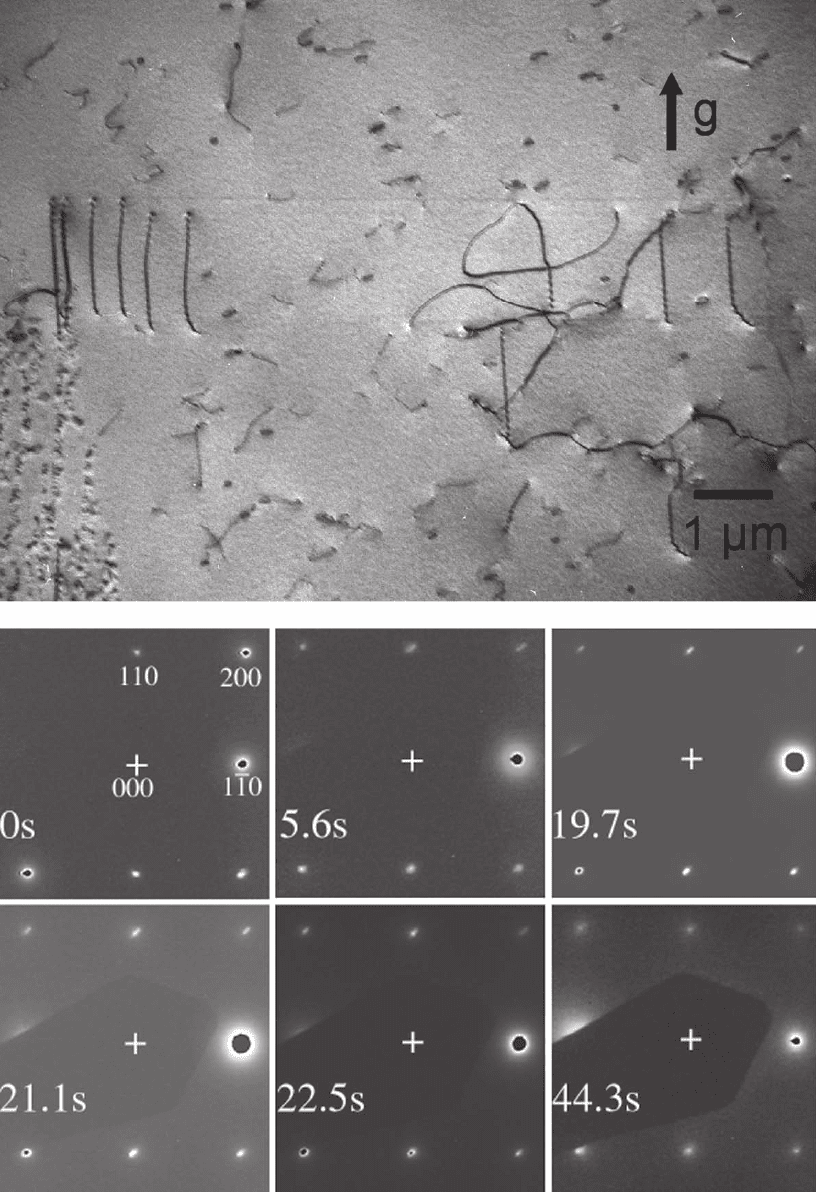
488 F.M. Ross
A
B

Chapter 6 In Situ Transmission Electron Microscopy 489
Most studies apply a uniaxial stress, although, for example, cyclic
shearing of Al single crystals has been described (Kassner et al., 1997).
Plastic deformation does not always require dislocation generation or
motion, and in V, Mo, and other bcc metals, deformation may occur by
formation of point defects rather than dislocations. This too can be
observed in situ with appropriate diffraction and imaging techniques
(Komatsu et al., 2003; Figure 6–24B). The challenge in all these strain-
ing experiments is to make them quantitative. One interesting tech-
nique for the measurement of local stress is through the curvature of
dislocations between pinning points (Pettinari et al., 2001).
As an intermediate case between single crystal and polycrystalline
metals, bicrystals provide the opportunity to apply the precision of
single crystal experiments to studies of strain transfer across boundar-
ies. For example, in symmetric Σ 3 Fe-4 at.% Si bicrystals, Gemperlova
et al. (2002) determined the primary slip system and studied the par-
ticular slip systems which can transmit stress across the boundary.
For polycrystalline metals, deformation can be investigated for thin
fi lms by either straining or heating. TEM is well suited to these thin
fi lm studies, although the sample geometry must still be controlled (for
example with respect to thickness uniformity) to avoid artifacts, and
surface passivation can affect the results. Straining experiments have
shown, for example, that the failure mode of polycrystalline Ni fi lms
depends on grain boundary structure (Hugo et al., 2003). Thermal
cycling experiments show grain boundary motion (see Section 2.1.3)
and the interactions of dislocations with grain boundaries and precipi-
tates (e.g., Kaouache et al., 2003). For thin Cu and Al fi lms, the higher
yield stress known for these materials has been related to particular
types of dislocation motion (Dehm and Arzt, 2000; Balk et al., 2003).
Threading dislocation motion and the effect of the passivation layer
have also been studied (Keller-Flaig et al., 1999; Legros et al., 2002).
Recent progress with nanoindentation stages (Section 5.3.1) and the
development of specimens incorporating microelectromechanical
(MEMS) free-standing fi lms (Section 5.1.2) promise further develop-
ments in understanding the deformation of polycrystalline fi lms in the
future.
We now consider intermetallics, which have been examined in situ
to understand the mechanism of their high temperature toughness and
phase transformations. Generally, dislocation dynamics change as a
Figure 6–24. Deformation of bulk crystals. (A) Dislocations moving away from a localized source
during in situ deformation of a MoSi
2
single crystal at ~900ºC. The loading axis is [201], which is a soft
orientation, and dislocations of Burgers vectors 1/2 <111> are activated on {110} planes. The traces of
these slip planes run horizontally. Owing to the generation of these dislocations in localized sources,
as shown here, planar slip dominates. The foil plane is (010) and g = [220]. (From Messerschmidt et
al., © 1998. Courtesy of Cambridge University Press.) (B) Deformation of a refractory metal, V, without
formation of dislocations. Diffraction patterns are obtained near the crack tip during deformation of
a notched foil. As the internal stresses increase, the spots expand perpendicularly to the crack so
appear elongated. (The central spot is masked to prevent overexposure.) Images do not show clusters
of point defects in V, unlike the case of Au strained under the same conditions. (From Komatsu et al.,
2003 with permission from Elsevier.)
490 F.M. Ross
function of temperature in these materials (e.g., Haussler et al., 1999).
Dislocation interactions, cross slip, and nucleation of loops control
work hardening, ductility, and the critical resolved shear stress (Legros
et al., 1996, 1997; Legros and Caillard, 2001). Dislocation motion during
creep has also been examined (Malaplate et al., 2004).
Polysynthetically twinned TiAl crystals have lamellar structures
with well-defi ned boundaries. By analogy with the bicrystal experi-
ments, strain propagation across these boundaries can be quantifi ed in
situ (Zghal et al., 2001; Pyo and Kim, 2005). Transformations in shape
memory alloys have already been mentioned in Section 2, and in situ
straining experiments relate the microstructural changes during defor-
mation to the stress-strain response (Jiang et al., 1997; Dutkiewicz et
al., 1995; Gao et al., 1996). The cracking of intermetallics is also impor-
tant in applications. Dislocations emitted at a crack tip can be analyzed
(in NiAl; Caillard et al., 1999), and amorphization can be detected at
crack tips (in NiTi ordered alloys; Watanabe et al., 2002).
Quasicrystals have interesting mechanical properties and disloca-
tion geometry. In situ heating and straining experiments have led to
the identifi cation of shear systems and models for dislocation motion
in these materials (Messerschmidt et al., 1999; Messerschmidt, 2001;
Caillard et al., 2002; Mompiou et al., 2004; Bartsch et al., 2005).
Ceramics have been important subjects of study since the 1970s, with
an interest in comparing dislocation motion at lower and higher tem-
peratures (e.g., in zirconia, Messerschmidt et al., 1997; alumina, Komatsu
et al., 1994; MoSi
2
, Guder et al., 2002). In quartz, strain-induced phase
transformations have been studied by combined straining/heating
experiments (Snoeck and Roucau, 1992).
We fi nally consider semiconductors. Kinetic studies show that dis-
location motion is consistent with glide governed by the Peierls mecha-
nism (Vanderschaeve et al., 2001). From dislocation motion and pinning,
the kink mean free path and formation and migration energies can be
determined (Gottschalk et al., 1993; Vanderschaeve et al., 2000; Kruml
et al., 2002). Radiation enhances the glide of dislocations by changing
some of these parameters (Section 8). Most studies have used low reso-
lution, dark fi eld imaging to record dislocation motion, but it is actually
possible to observe directly the thermal motion of kinks in Si using a
high resolution forbidden refl ection imaging technique (Kolar et al.,
1996). This generates fascinating information. The kink formation
energy and unpinning barrier can be derived from the distribution and
pinning of individual kinks, and videos show directly that kink migra-
tion is the rate limiting step in dislocation motion. This technique
should be applicable to other materials and is expected to lead to
further advances in our understanding of dislocation motion (Spence
et al., 2006).
5.1.2 Deformation of Multiphase, Composite, or Layered Materials
Deformation experiments in multiphase materials, such as dispersion
strengthened alloys, are particularly important in materials develop-
ment, since they show how strain is transmitted between components.
Dispersion strengthened Al alloys have been examined extensively, to
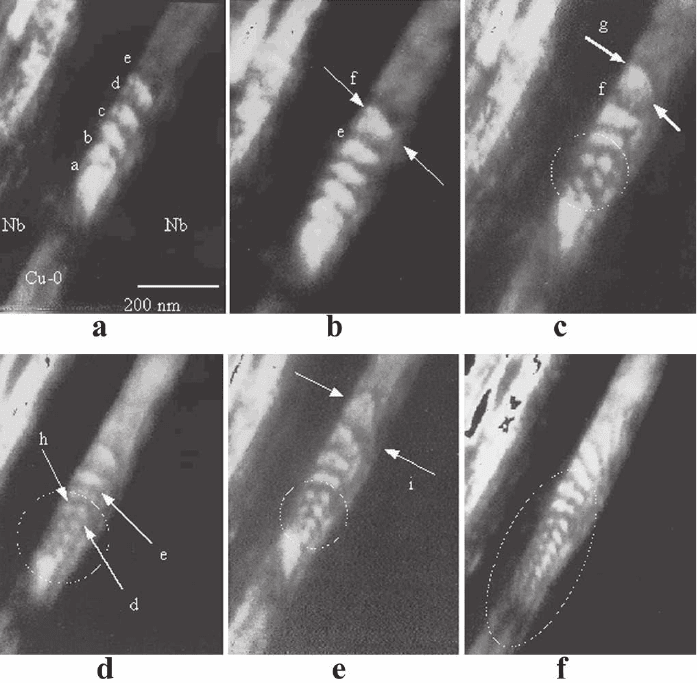
Chapter 6 In Situ Transmission Electron Microscopy 491
characterize the nucleation of dislocations at precipitates and their
motion past precipitates (Vetrano et al., 1997; Hattenhauer, 1994). These
phenomena are critical in high temperature deformation of such alloys.
Other phenomena, such as grain boundary migration, coalescence, and
elimination of subboundaries, occur during dynamic continuous crys-
tallization on loading in the TEM (Vetrano et al., 1995; Dougherty et
al., 2003), with in situ studies helping to understand the processes. Steel
Figure 6–25. Deformation in a Cu–Nb multifi lamentary composite. Nanocomposite materials are
used in wires requiring high strength and high conductivity. This sample was prepared by cold
drawing an Nb rod inside a Cu jacket several times until a composite was formed consisting of Cu–
17%vol–Nb with 10
7
Nb fi laments 40 nm across in Cu. The Cu channels have <111> texture, the Nb
fi laments have <110> texture, and the Cu–Nb interfaces are semicoherent. The sequence of images
shows the introduction of dislocations under an applied force of 8 N. At this point Cu is plastically
deformed while Nb is still elastically deforming. The area shown is a Cu channel of width about
100 nm (white) between two Nb fi laments (black). At the beginning of the sequence (image a), fi ve
dislocation loops are present on parallel planes. A few seconds later the sixth and seventh loops appear
(images b and c). By the end of the sequence 13 loops are present, and they have interacted to produce
a honeycomb pattern (circles in images c–f). This dislocation behavior is used in a plastic fl ow model,
which explains the very high ultimate tensile stress of fcc–bcc nanocomposite structures. (From Thilly
et al., 2002, with kind permission of Taylor and Francis Ltd.)
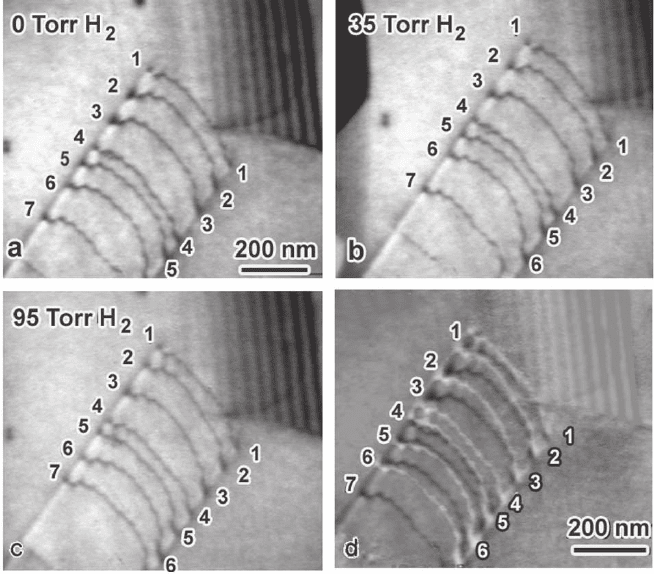
492 F.M. Ross
is of course another multiphase material whose behavior in situ has
been studied for some time (Caillard et al., 1980); industrially relevant
studies of dislocation motion and slip transmission through interfaces
in steels continue (Verhaeghe et al., 1997; Janecek et al., 2000; Zielinski
et al., 2003). Many other nanocomposite materials provide interesting
examples of dislocation-interface interactions. One such is shown in
Figure 6–26 (Thilly et al., 2002) and other work is reviewed by Louchet
et al. (2001).
Techniques developed for multiphase materials extend easily to
engineered multilayers, where the interaction of dislocations or cracks
with interfaces is of interest. Cross sections of multilayers may be pre-
pared using a FIB to form a thin section at which cracks will initiate
(Wall et al., 1995; Wall and Barbee, 1997). Alternatively, multilayers (or
thin fi lms) may be integrated into a mechanical testing stage. One
example is a piezo stage for cyclic loading of solder thin fi lms, use to
show that cavitation is the dominant fatigue damage mechanism (Tan
et al., 2002). In this stage, a multilayered structure is fabricated which
includes the material of interest as well as a piezoelectric layer.
The future for thin fi lm and multilayer studies undoubtedly lies in
extending this sort of approach, achieving controlled deformation
using MEMS-based techniques. MEMS force sensors and displacement
Figure 6–26. Dislocation motion in H atmosphere. Showing the effect of H on the mobility of disloca-
tions in 310S stainless steel. (a) dislocation confi guration in vacuum under constant load; (b) 35 Torr;
(c) 90 Torr of hydrogen; (d) composite image formed by subtracting (c) from (a). (Reprinted with per-
mission from Robertson and Teter, © 1998 by the American Physical Society.)
Chapter 6 In Situ Transmission Electron Microscopy 493
measurement systems can be integrated with the fi lm of interest, allow-
ing for quantitative experiments. Stages for uniaxial tensile testing of
free-standing thin fi lms have already been demonstrated (Haque and
Saif, 2003, 2004, 2005; Hattar et al., 2005), with initial results on poly-
crystalline Al thin fi lms, and other functionalities such as heating are
under development (Zhang et al., 2005). We anticipate further exciting
progress in this area.
5.1.3 Deformation in a Controlled Atmosphere
By combining mechanical testing with controlled environment TEM,
a very important objective, understanding the mechanism of hydrogen
embrittlement of steels, has been achieved (Figure 6–27). In situ strain-
ing experiments carried out in an environmental cell showed that
solute hydrogen can increase the speed at which dislocations move
through the material, as well as increasing the rate of crack propagation
(Robertson and Teter, 1998; Teter et al., 2001; Sofronis and Robertson,
2002). By quantitatively analyzing dislocation dynamics on adding and
removing hydrogen, competing mechanisms for embrittlement could
be distinguished. The hydrogen shielding model was confi rmed, in
which the hydrogen-enhanced localized plasticity mechanism is the
shielding of the dislocation from interactions with other strain centers
such as pinning points, other dislocations, or solutes. Few other materi-
als have been strained in a controlled atmosphere, although Maeda et
al. (2000) showed that the incorporation of hydrogen from a plasma
increases the motion of dislocations in semiconductors. Further studies
could provide a sensitive probe of dislocation properties and
interactions.
5.2 Relaxation of Epitaxially Strained Materials
In this section, we consider another method of straining a material:
growth of the material epitaxially on a lattice mismatched substrate.
As the layer is deposited a high intrinsic stress builds up, and, once
above a “critical thickness,” the layer may relax by forming a network
of dislocations at the layer-substrate interface (Figure 6–27A, B). This
phenomenon can be examined in situ. First, a layer thicker than the
critical thickness is grown, but at a temperature that is too low to allow
dislocation nucleation or propagation. Then a plan view TEM specimen
is prepared and heated in situ, allowing relaxation to be observed as a
function of temperature. The advantage of this type of experiment is
that the stress state is very well defi ned, making this a situation where
dislocation dynamics can be measured quantitatively. Such studies are
motivated by their importance to the microelectronics industry, since
the positions of individual dislocations, the density of threading arms,
and the motion of dislocations during processing are known to affect
device performance.
This work was carried out for the system Si
1-x
Ge
x
on Si, with x
ranging from about 0.05 to 0.3 (Hull et al., 1989, 1991). Measurements
of dislocation velocity as a function of layer parameters are shown in
Figure 6–27C. For capped layers, the results supported the diffusive
kink pair model of dislocation propagation, and for uncapped layers
they showed that propagation is through motion of single kinks.
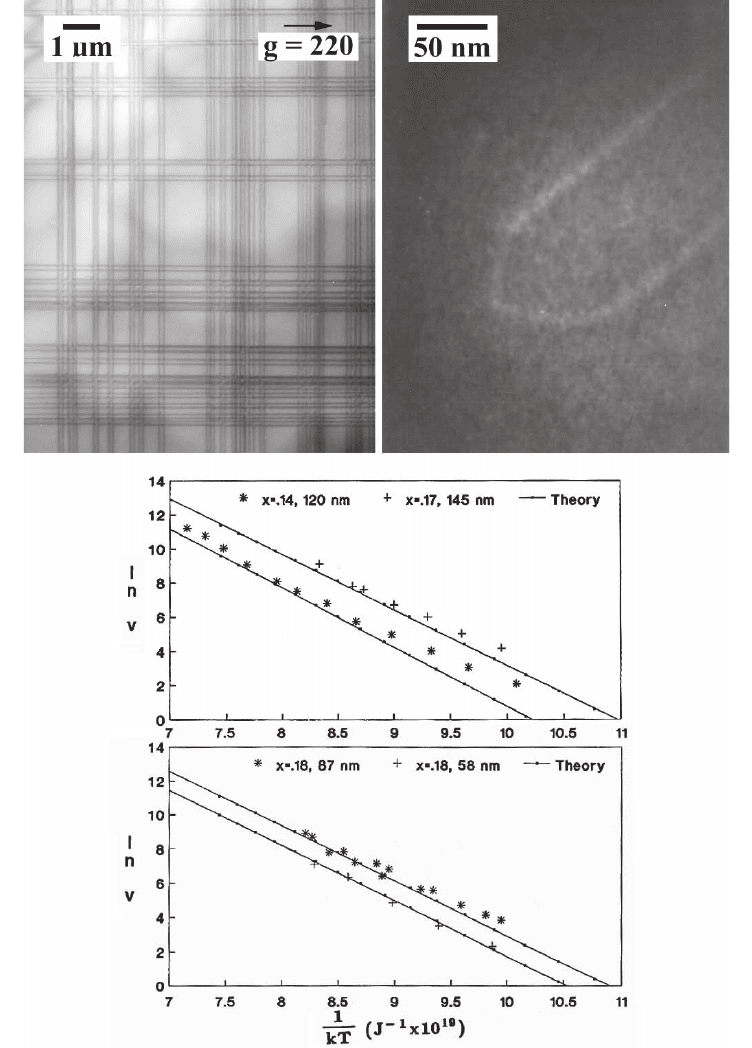
494 F.M. Ross
A
C
B
Figure 6–27. Dislocation dynamics in SiGe heterostructures. (A) Image showing the typical disloca-
tion structure in SiGe heterostructures. Plan-view TEM image of a relaxed 300 nm Si/150 nm Si
80
Ge
20
/
Si(001) heterostructure. Closely spaced interfacial dislocation pairs are segments of the same disloca-
tion loop at the top and bottom SiGe/Si interfaces. (From Stach et al., © 1998b Courtesy of Cambridge
University Press.) (B) 220 g, 3 g weak-beam dark-fi eld micrograph of a threading dislocation segment
connecting two interfacial dislocation segments. (From Stach et al., 1998b.) (C) Measured dislocation
velocities compared with predictions of the double-kink theory for SiGe layers buried beneath a
300 nm Si cap, as in (A). The Ge concentrations, x, and epilayer thicknesses are given on the graphs
while the dislocation velocities are given in Angstrom s
−1
. The fi tting parameter used in the model is
half the double-kink nucleation energy, taken as 1.0 eV. (Reprinted with permission from Hull et al.,
1991. American Institute of Physics.)
